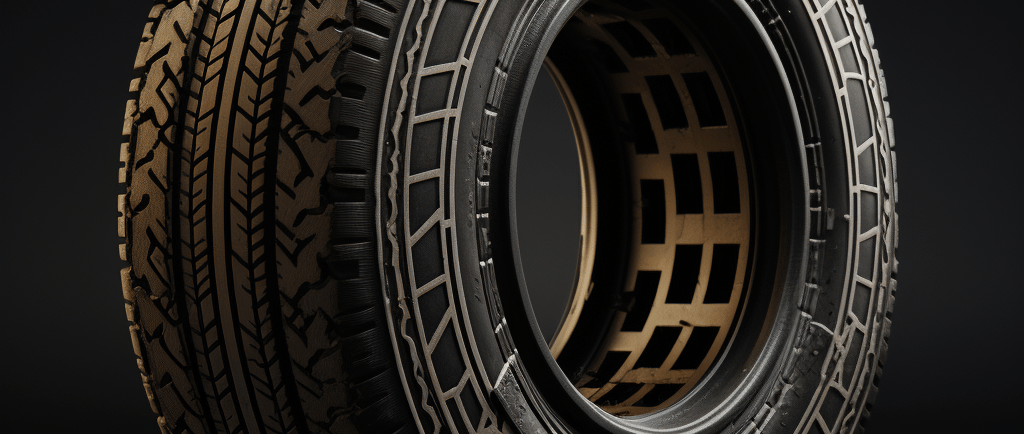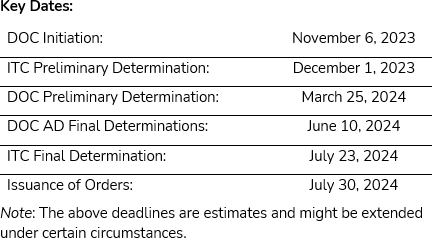Truck and Bus Tires from Thailand
U.S. launches antidumping investigation


On October 17, 2023, the United Steel, Paper and Forestry, Rubber, Manufacturing, Energy, Allied Industrial and Service Workers International Union ("Petitioner"), filed a petition with the U.S. International Trade Commission (ITC) and the U.S. Department of Commerce (DOC). The petition seeks the imposition of antidumping duties on imports of truck and bus tires from Thailand. Notably, the DOC has had antidumping and countervailing duty orders on such imports from China since 2019.
Truck and bus tires, according to federal regulations, must be able to support vehicles with GWVR of more than 10,000 pounds. The detailed proposed scope of the merchandise under consideration is provided below.
The Focus of the Investigations:
1. The DOC will calculate the dumping margins for foreign exporters of truck and bus tires.
2. The ITC will assess whether imports from Thailand are causing material injury to the U.S. truck and bus tire manufacturing industry
Dumping refers to the act of a foreign company selling a product in the U.S. at a price below its normal value. This value is determined by the foreign company’s sales in its home market, sales in a comparison market, or even below cost. In essence, this process evaluates price discrimination. Such analysis produces a percentage termed the "margin of dumping." The Petitioner alleges a dumping margin of 47.81 percent for exporters of truck and bus tires from Thailand.
Given the vast number of producers and exporters of truck and bus tires, the DOC is expected to examine only two companies. Typically, these companies are chosen based on their export volume to the U.S. They will be mandated to actively participate in the investigation. Moreover, the dumping margins determined for these companies will likely set the duty rates for other producers and exporters.
Injury investigation is usually initiated immediately after the petitions are filed. The ITC will have 45 days to reach a preliminary determination. Producers, importers, and exporters can participate in this investigation by responding to questionnaires about the production, importation, and sales of aluminum extrusions. These questionnaires are set to be issued soon. All mentioned parties can also defend themselves at the ITC against claims that imports are harming the U.S. industry.


Retroactive duties may be required for merchandise currently in transit or expected to be shipped soon. If Petitioner later alleges critical circumstances and dumping is determined, imports arriving post-October 17, 2023 (petition filing date) but prior to the AD preliminary determination date could face retroactive cash deposits.
REQUESTED SCOPE OF MERCHANDISE UNDER CONSIDERATION
The scope of the investigation covers truck and bus tires. Truck and bus tires are new pneumatic tires, of rubber, with a truck or bus size designation. Truck and bus tires covered by the scope may be tube-type, tubeless, radial, or non-radial.
Subject tires have, at the time of importation, the symbol “DOT” on the sidewall, certifying that the tire conforms to applicable motor vehicle safety standards. Subject tires may also have one of the following suffixes in their tire size designation, which also appear on the sidewall of the tire:
TR—Identifies tires for service on trucks or buses to differentiate them from similarly sized passenger car and light truck tires; and
HC—Identifies a 17.5 inch rim diameter code for use on low platform trailers.
All tires with a “TR” or “HC” suffix in their size designations are covered by the scope regardless of their intended use.
In addition, all tires that lack one of the above suffix markings, as well as all tires that include any other prefix or suffix in their sidewall markings, are included in the scope, regardless of their intended use, as long as the tire is of a size that fits trucks or buses. Sizes that fit trucks and buses include, but are not limited to, the numerical size designations listed in the “Truck-Bus” section of the Tire and Rim Association Year Book, as updated annually. The scope includes all tires that are of a size that fits trucks or buses, unless the tire falls within one of the specific exclusions set out below.
Truck and bus tires, whether or not mounted on wheels or rims, are included in the scope. However, if a subject tire is imported mounted on a wheel or rim, only the tire is covered by the scope. Subject merchandise includes truck and bus tires produced in the subject country whether mounted on wheels or rims in the subject country or in a third country. Truck and bus tires are covered whether or not they are accompanied by other parts, e.g., a wheel, rim, axle parts, bolts, nuts, etc. Truck and bus tires that enter attached to a vehicle are not covered by the scope.
Specifically excluded from the scope are the following types of tires: (1) Pneumatic tires, of rubber, that are not new, including recycled and retreaded tires; (2) non-pneumatic tires, such as solid rubber tires; and (3) tires that exhibit each of the following physical characteristics: (a) The designation “MH” is molded into the tire’s sidewall as part of the size designation; (b) the tire incorporates a warning, prominently molded on the sidewall, that the tire is for “Mobile Home Use Only;” and (c) the tire is of bias construction as evidenced by the fact that the construction code included in the size designation molded into the tire’s sidewall is not the letter “R.”
The subject merchandise is currently classifiable under Harmonized Tariff Schedule of the United States (“HTSUS”) subheadings: 4011.20.1015 and 4011.20.5020. Tires meeting the scope description may also enter under the following HTSUS subheadings: 4011.90.10, 4011.90.20, 4011.90.80, 8708.70.45, 8708.70.60, and 8716.90.5059. While HTSUS subheadings are provided for convenience and for customs purposes, the written description of the subject merchandise is dispositive.




